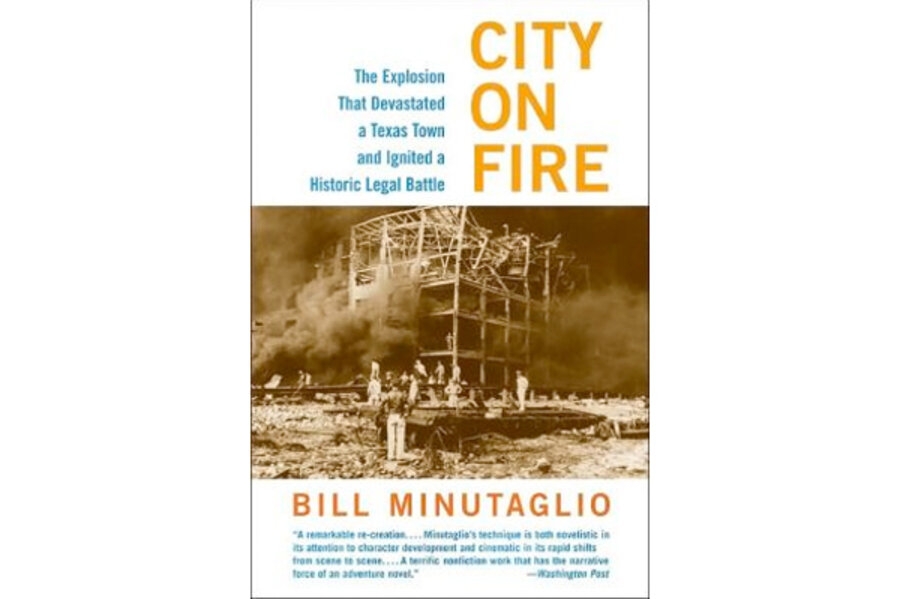Texas plant explosion: A deadly 1947 explosion in Texas City was also caused by ammonium nitrate
Loading...
Just after World War II, Texas City – next to Galveston and not far from Houston – was the boom-iest of boom towns. The population was zooming skyward thanks to an influx of workers seeking jobs in the gritty worlds of oil, gas, metal, and chemicals.
"Everyone who lives here," a local priest said, "is a refugee steered to Texas City by a rising tide."
But the sea itself brought horror 66 years ago last week. A ship full of ammonium nitrate exploded in the Texas City port, setting off a disastrous chain reaction that left the city in ruins. Hundreds died, and thousands were wounded.
Ammonium nitrate appears to also be responsible for the deadly explosion last week at a fertilizer factory in West, Texas.
Why is this chemical compound so dangerous? How does the 1947 disaster compare to this week's tragedy? And what is the legacy of Texas City? No one may know the answers better than Texas journalist and historian Bill Minutaglio, author of 2003's well-received "City on Fire: The Forgotten Disaster That Devastated a Town and Ignited a Landmark Legal Battle."
Q: When I think of fertilizer, manure comes to mind. How does ammonium nitrate fit in?
A: Ammonium nitrate can be used to fertilize farms and fields because it is high in nitrogen. In large amounts, given the right conditions — including heat and fire – it can explode. People intent on malevolence have long known about the compound's explosive capabilities.
Q: What was ammonium nitrate used for in 1947?
A: The ammonium nitrate that blew up in 1947 in Texas City, which what some say is the greatest industrial disaster in the most industrialized nation in the world, was intended to be used as fertilizer. It was packed in bags that were stamped with the word "fertilizer" and was going to be sent from Texas City to Europe, on freighters, in order to assist in the revitalizing of farms in Europe.
Q: Why was the Texas City disaster so widespread and deadly?
A: According to official reports, 581 people died. Some believe the number to be higher. Some say as many as 5,000 people were wounded.
There were multiple explosions and fires. Enormous petrochemical plants and oil tanks were destroyed and the disaster resulted in untold amounts of toxic chemicals being released into the land, air and water.
Q: With the limited information we have now, can you compare the 1947 explosion way to the disaster this week?
A: I don't think it is entirely fair to compare these disasters because the time periods are different, the geography is different, and there has been significant attention paid to ammonium nitrate and combustible fertilizers since 1947.
That said, these incidents both occurred in small towns that were just horrifically overwhelmed, towns filled with hard-working folks, people who work with their hands in farms or factories or plants. Similar questions are emerging: Could this have been prevented?
Q: How is the Texas City disaster memorialized, and how has it affected that community to this day?
A: It is recognized in various ways – with a memorial area, with anniversary commemorations. The city is well aware of its history. The main library in Texas City is a wonderful repository of history, oral histories, photographs.
It's hard to say how the event affects the community now. I think, in general, people in Texas City are mindful of the giant, sprawling industrial complex that rings the city.
It is enormous, and the people in the city are very proud of the fact that large portions of America would not function as they do without the goods and services from Texas City. America would be radically different, probably malfunctioning according to some people, without the energy and petrochemical nexus of Texas City.
Q: Why do you think the Texas City disaster is largely forgotten? Does it just not fit into a wider historical narrative?
A: People remember Texas City when they want to, through the prism of the media that revives the story when events like the one in West occur. There have been other disasters in Texas City, by the way, including one in 2005 when 15 people died and 170 or so were injured.
Q: What lessons can we learn from Texas City that will help the community in West?
A: Greater attention has to be paid to safeguard communities, to provide oversight, to commit to government inspections, to err on the side of caution.
In Texas City, in 1947, people said they were simply not made aware of the dangers of ammonium nitrate. They wished they had been told.
Q: What is the ultimate legacy of Texas City?
A: Texas City is taught in emergency response schools. People who work at FEMA and other response agencies know about Texas City and study it. If they don't, they should.
Texas City offered manifest lessons on how to control chaos and how to manage emergencies. That's an important and enduring legacy, and many people in the United States are completely unaware of it.
Texas City also led to the first massive class-action filed against the federal government. It opened the door, in its way, for ordinary people to challenge the government on a legal basis.
Whether by accident or design, there have been far too many unfolding tragedies involving loss of life and large numbers of injuries. I hope that the lessons of West, Texas City, Newtown, and Boston will make us even more aware and make us think more about how to perhaps anticipate problems while still encouraging our children to meet the world with open arms.
Randy Dotinga is a Monitor contributor.







